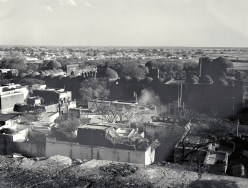M04
ベーガンプーリー=マスジッド(B![]() gamp
gamp![]() r
r![]() Masjid)として知られており,ベーガンプル部落の西南隅にある。附図.G-12
Masjid)として知られており,ベーガンプル部落の西南隅にある。附図.G-12
このモスクは,現存するデリー諸王朝時代に属するモスクとしては,最大の規模をもつものの一つであって,外辺が東西95メートル・南北91メートルに達する。広い内庭を囲んで,西側に礼拝室をもち,その他の三方には,奥行1間の廻廊をめぐらしている。これらの廻廊の中央には,それぞれドームをいただく門があり,そのうちでは東門が最大で,主入口をなしている。西側の礼拝室は,高いドームをいただく中央礼拝室と,その南北につづく,それぞれ間口8間・奥行3間の礼拝側室とからなっている。中央礼拝室の正面には,ミーナールを模した塔を両端にもつ,巨大なパイロン風のアーチが力強く立ち,このモスクに堂々たる風格をそえいる。礼拝側室の,南北にはしるなかの間と,廻廊のすべての間の上に,それぞれ,小さなドームが連続して並んでいるさまもまた壮観である。北側の礼拝側室のさらに北側には,16.7メートルと21.3メートルの,東と北とにヴェランダをもつ建物が張り出しているが,これは,おそらくは,限られた人びとのために用意されたものと思われ,従来も,ムッラー=ハーナ(聖職者のための部屋),あるいはザナーナ(婦人のための部屋)といわれてきた。
このモスクは,一般には,トゥグルク朝のフィーローズ=シャー時代に建てられたものといわれてきたが,その建立の歴史に関しては,なお,検討の余地がのこされているように思われる。しかし,構造・様式からみて,トゥグルク朝時代に属することは,ほぼ疑いない。ちなみに,このモスクの北方約60メートルのところには,トゥグルク朝のムハンマド=シャーの建立と伝えられ,後にビジャイ=マンディルとよばれてきた宮廷建造物の廃墟がのこっているが,それとの関連についても,十分な考慮が払われて然るべきであろう。第Ⅱ期。
東研.Ⅷ-33;ASI.Ⅲ-270
The Begamp![]() r
r![]() Masjid. Located in the southwestern section of Begamp
Masjid. Located in the southwestern section of Begamp![]() r village. Grid ref. G-12. Ill. 13-14.
r village. Grid ref. G-12. Ill. 13-14.
This is one of the largest existing mosques dating from the Delhi Sultanate. The exterior measures 91 metres north to south and 95 metres east to west. It has a vast courtyard with a prayer hall on the western side and single-bayed arcades on the other three sides, with domed gateways located in the centre of each. The main gateway is on the east. The prayer hall has a main chamber surmounted by a large dome with adjoining prayer rooms, eight bays wide and two bays deep, on the northern and southern sides. The severe but imposing facade of the central prayer hall consists of a very tall arch with tapering pylon-shaped quoins at either end. A total of 64 small domes surmount the prayer hall and arcades. Another building, 16.7 m by 21.3 m, with balconies on the north and east, projects from the northern side of the northern prayer room. This is thought to have had a specialized use; it has long been called the Mullah’s Room (mull![]() h-kh
h-kh![]() na) or the women’s room (zan
na) or the women’s room (zan![]() na).
na).
This mosque is generally considered to have been built in the time of F![]() r
r![]() z Sh
z Sh![]() h Tughluq (r. 1351-88), but much still remains unclear about its construction history. However, there is no doubt that it belongs to the Tughluq dynasty in terms of building technique and style. About 60 metres north of the mosque lies Bijay Mandal (O. 6, Ill. 145-146), probably part of a palace complex said to have been constructed by Mu
h Tughluq (r. 1351-88), but much still remains unclear about its construction history. However, there is no doubt that it belongs to the Tughluq dynasty in terms of building technique and style. About 60 metres north of the mosque lies Bijay Mandal (O. 6, Ill. 145-146), probably part of a palace complex said to have been constructed by Mu![]() ammad Sh
ammad Sh![]() h Tughluq (r. 1325-51); a possible connection between the palace and the mosque is of considerable interest. Period Ⅱ.
h Tughluq (r. 1325-51); a possible connection between the palace and the mosque is of considerable interest. Period Ⅱ.
IOC:Ⅷ-33; ASI:Ⅲ-270.





